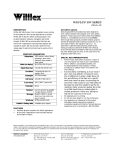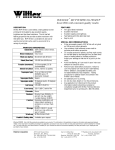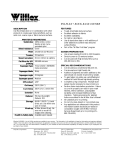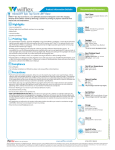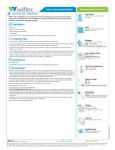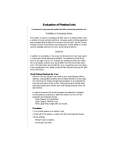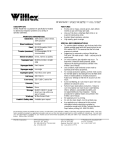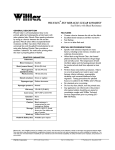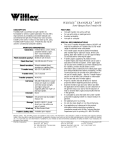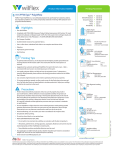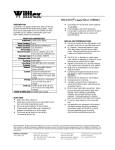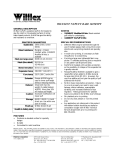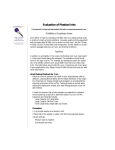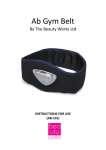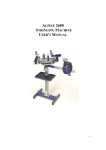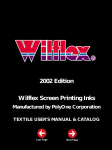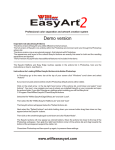Transcript
WILFLEX® ONE-STEP NYLON DESCRIPTION Wilflex One-Step Nylon Ink is formulated to print onto “untreated” nylon. The ink can be used like a standard plastisol ink and will not dry in the screen or harden in the container. OSN inks flash quickly to allow multi-ink production, with cure/gel temperatures of 300 F (149 C). • • PRINTER'S PARAMETERS Substrates Untreated 100 percent nylon Mesh (OSN White) Mesh (OSN Colors) Stencil emulsion Squeegee type Squeegee blade Gel temp Cure temp Extender Reducer 60-110 threads/in (24-43 threads/cm) 110-195 threads/in (43-77 threads/cm) Conventional direct or capillary films 60 to 90 durometer 155 F (168 C) 300 F (149 C) entire film One Step Nylon Extender for process applications None Do not trap or overprint on fluorescent colors Storage 65-90 F (18-32 C). Avoid direct sun. Use within one year of receipt. Mineral spirits Health & Safety data • Straight edge Caution Wash-up • fabric. Therefore, scratch testing should not be a quality criteria immediately following printing. The Hugger Catalyst chemistry activates upon exposure to moisture in the air. The amount of moisture exposure determines the shelf life of the mixed ink. Pot life generally ranges from 4-8 hours. Opened Hugger Catalyst containers should be squeezed to push air out of the bottle and then sealed tightly. If left open or loosely sealed, Hugger will crystallize and solidify in the bottle. Ink mixed with Hugger Catalyst must be removed from the screen immediately following printing with cleaning solvents to prevent permanent mesh damage. Squeegees and any other printing apparatus must cleaned immediately also. Preprinting and testing are necessary prior to production. Available upon request FEATURES • Excellent for printing untreated nylon fabrics ranging from coarse deniers used in back-packs and luggage to the finer deniers used in garments/umbrellas USE OF HUGGER CATALYST • One-Step Nylon inks should NOT be used on waterproofed satin jackets or when printing onto waterproofed nylon materials. If the nylon material has been treated to repel water, the waterproofing must be removed, and the addition to ink of Hugger catalyst at 10 percent by weight will be necessary. • Wipe down the print area with rubbing alcohol or acetone if printing on a tightly weaved jacket material. • The cross-link reaction between the catalyst and ink takes approximately 48-72 hours to fully bond to the SPECIAL RECOMMENDATIONS • OSN ink will adhere to 100 percent polyester fabrics but preprinting and testing for bleed resistance are necessary to determine overall results. • When OSN fluorescent colors are printed on top of a flashed white, there will be improved opacity and no reaction between colors. However, if white (or any non-opaque color) is printed on top of a fluorescent color, color migration will occur. To avoid this, do not trap or overprint on fluorescent colors. • Hot cleaning solvents (containing Toluene, Xylene, and Acetone etc.) will react with this ink causing hardening in the screen. • Due to differences in power, height above ink film and efficiency of the flash drying unit, specific dwell time cannot be given. Field testing showed significantly faster flash times than other catalyzed systems currently available. • Use consistent, high tensioned screen mesh to optimize performance properties. • Perform fusion tests before production. Failure to cure ink properly can result in poor wash fastness, inferior adhesion, unacceptable durability, and increased likelihood of dye migration. Testing procedures for plastisol fusion are outlined in the Wilflex User's Manual. • Stir plastisols prior to printing. • Do not dry clean, bleach or iron the printed area. • Any application not referenced in this product information bulletin should be pre-tested or consultation sought with Wilflex Technical Services Department prior to printing (US - 800-735-4353). Effective 5/6/02. Not all Wilflex products are available in every country. The information in this publication is based on information and experience believed reliable. Since many factors may affect processing for an application, processors must carry out their own tests and experiments to confirm suitability for intended use. You must make your own determination of suitability for your intended use and environmental acceptability, the safety and health of your employees, and purchasers of your product. PolyOne Corporation www.polyone.com 8155 Cobb Center Drive Tel: 800-326-0226; 770-590-3500 Fax: 678-290-2749 Unit 12, Orbital One Dartford, Kent DA1 1QG UK Tel: (+44) 01322 277778 77 Parkhurst Dr, Knoxfield 3180 Tel: (+61) 3 9887 1522
